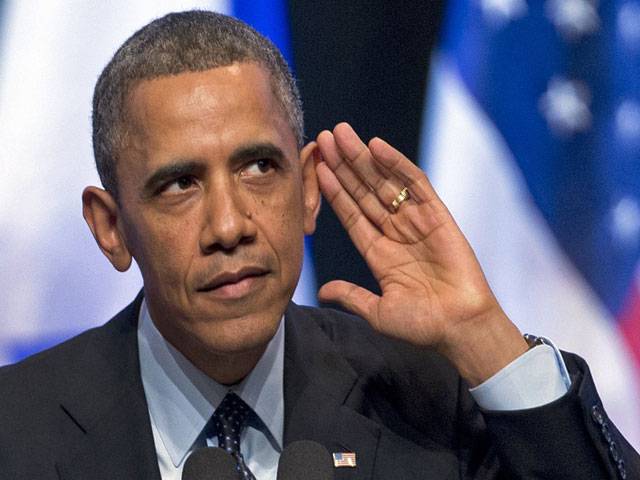AFP
WASHINGTON
US President Barack Obama said Saturday that climate change poses the world’s biggest single threat.
‘Today, there’s no greater threat to our planet than climate change,’ Obama said in his weekly address, which had an environmental theme to mark Earth Day on April 22. ‘Climate change can no longer be denied, or ignored,’ he added, noting that 2014 was the hottest year on record.
The United States is the second largest greenhouse gas emitter after China, and Obama has pledged to reduce US climate pollution by 26-28 percent from 2005 levels by 2025. ‘This is an issue that’s bigger and longer-lasting than my presidency,’ Obama said. ‘This is the only planet we’ve got. And years from now, I want to be able to look our children and grandchildren in the eye and tell them that we did everything we could to protect it.’ Obama said he would travel to the Florida Everglades, a region known for its tropical wetlands, on Wednesday to talk about the ways in which climate change affects the economy. ‘Rising sea levels are putting a national treasure - and an economic engine for the South Florida tourism industry - at risk,’ Obama said of the famous wetlands. Obama, who has made the fight against climate change one of his priorities, hopes to help seal a global deal at an international climate conference in Paris in December.
Moreover, plans by 34 nations for fighting climate change beyond 2020 would leave the world on track for warming well above the limits agreed with the U.N., and Moscow’s strategy is especially weak because it lets Russia’s greenhouse gas emissions rise, experts said on Friday.
The United States, the 28-nation European Union, Russia, Mexico, Switzerland, Norway and Gabon have so far submitted strategies to the United Nations, meant as the building blocks of a global deal to be agreed in December at a summit in Paris. ‘We regret that so few have been submitted,’ said Miguel Arias Canete, European Climate Action and Energy Commissioner. So far, national plans cover about 30 percent of world emissions. March 31 was a first, informal deadline for plans, known as Intended Nationally Determined Contributions (INDCs), that are meant to help slow the effects of climate change. Most nations are waiting to submit their plans. The Climate Action Tracker (CAT), compiled by scientists, said pledges so far put the world on track for average temperatures in the year 2100 three to four degrees Celsius (5.4 to 7.2 degrees Fahrenheit) higher than they were in pre-industrial time. That is well above a U.N. goal of a maximum 2 degrees C (3.6F) rise.
‘Hopefully, there can be a dynamic to increase ambition’ in coming months, said Niklas Hoehne, a founding partner of the New Climate Institute, which helps compile the CAT. CAT gave Russia an ‘inadequate’ rating and assessed others as ‘medium’. It said reports that Japan was considering cuts of only 20 percent by 2030 would also be ‘inadequate’.
Russia’s goal is to limit emissions to 25 to 30 percent below 1990 levels by 2030. But its emissions were 32 percent below the 1990 benchmark in 2012, a legacy of the collapse of Soviet-era smokestack industries, meaning a rise by 2030. Other INDCs use varying yardsticks that complicate plans for putting pressure on laggards to raise ambition before the Paris meeting.
Washington plans emissions cuts of up to 28 percent below 2005 levels by 2025, for instance, while the European Union promises cuts of 40 percent from 1990 levels by 2030. ‘It will be very hard to put INDCs side by side and say ‘this one is strong enough and this one isn’t’,’ said Frank Melum, a senior analyst at Thomson Reuters Point Carbon.
Friday, April 19, 2024
‘No greater threat than climate change’

3:56 PM | March 28, 2024
4:14 PM | March 23, 2024
Opposition objects to oath-taking of MNAs amid lawlessness
5:15 PM | April 19, 2024
Electioneering to end on Friday night ahead of by-polls in 21 constituencies
5:14 PM | April 19, 2024
Fawad Chaudhry granted bail in 14 cases related to May 9 violence
5:13 PM | April 19, 2024
British Army chief lauds Pakistan Army's professionalism, expertise
5:12 PM | April 19, 2024
Israeli aircraft fire missiles at Air Force assets in Iran: Report
3:52 PM | April 19, 2024
A Tense Neighbourhood
April 19, 2024
Dubai Underwater
April 19, 2024
X Debate Continues
April 19, 2024
Hepatitis Challenge
April 18, 2024
IMF Predictions
April 18, 2024
Kite tragedy
April 19, 2024
Discipline dilemma
April 19, 2024
Urgent plea
April 19, 2024
Justice denied
April 18, 2024
AI dilemmas unveiled
April 18, 2024
ePaper - Nawaiwaqt
Advertisement
Nawaiwaqt Group | Copyright © 2024





